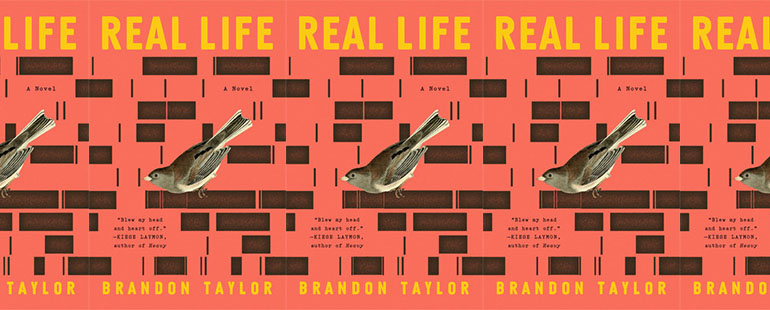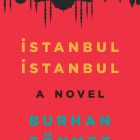Real Life by Brandon Taylor

Real Life
Brandon Taylor
Riverhead | February 18, 2020
Covering one weekend in late summer, Real Life—the debut novel of Brandon Taylor—starts with Wallace, an introverted, gay, black biochemistry graduate student, meeting his friends at the lake in an unnamed Midwestern college town. At the onset, we know Wallace is different from his cohort. He’s the only black student in his program and one of the few black residents in town. Among his lean and vegan classmates, he’s athletic yet fat and once made the mistake of bringing Swedish meatballs to one of their parties. An introvert living among students who love dinner parties, Sunday brunches, and boating excursions on the lake, Wallace “never [feels] like they wanted him there.” At the same time, he’s socially awkward and deeply suspicious of social interactions and “the contours and confines of social expectations.”
Alienated but forced to be a part of the community, Taylor’s protagonist quietly navigates treacherous territory. In the homogenous world of the Midwestern town, Wallace is subject to microaggressions and at times outright racism and homophobia. He’s often called aside for talking down or being too aggressive to his classmates—the presumption being a black student couldn’t possibly know better than his white classmates, even though he sees through their mistakes in the lab. Though he passes his exams, his white advisor still speaks as if her letting him stay enrolled is an act of “bestowing blessings” or “bestowing beneficence” or “bestowing irrefutable grace…as though she were saving him.” In one explosive scene, a white classmate accuses him of being a misogynist who relies on his race and sexuality instead of hard work, though Wallace is one of the few students who stays late in the lab, even working through summer break. Even his accuser admits Wallace’s work ethic as she hurls epithets at him: “You dump all of your precious little time into this lab[.]”
It’s enough to make him consider quitting the program—an idea that, once vocalized, creates a larger rift between him and his classmates, requiring Wallace to ask himself what he would risk by throwing away an academic life for something in the “real world.” Should he leave his graduate degree—its career path of money, fellowships, and jobs—and eventually become, like his advisor, a nationally recognized senior in his field? For Wallace, as the first in his family to go to college, the Midwest represents an escape not only from his home state of Alabama and the South, but also poverty and a dark, violent past for which his parents are responsible. This past comes back to haunt him when news of his father’s death from cancer arrives. To have left Alabama means a kind of success—but one with the heavy psychological cost of isolation. To leave college would be another kind of disaster: he would have failed at his escape, and perhaps even have to return home, where he’s reminded of his trauma.
The question of leaving hangs over the last weekend of the summer as Wallace becomes embroiled in the drama of his friends, who are also struggling to accept the lives they thought they wanted. His tennis buddy, Cole, thinks his boyfriend is cheating on him, an insult in the face of the relationship he tried so hard to create, a semblance of monogamous normalcy “far from the Sodom and Gomorrah in the public’s opinion.” Emma, another classmate, thinks her boyfriend is avoiding her graduate student friends, leaving her feeling lonely despite being in the midst of company.
Meanwhile, one rough, nonchalant classmate named Miller begins questioning his sexuality and uses Wallace to experiment—a relationship that never truly evolves in part because of Wallace’s reticence and the white, male privilege Miller holds. It is Miller who first invites himself to Wallace’s house and initiates the relationship, and though the sex is consensual, it is for Miller’s pleasure more than Wallace’s, who is indifferent to sex. (“It was fine,” Wallace says after Miller asks how sex with him was). The gap between their experiences comes to the forefront when they trade stories of their personal damages—Wallace’s own violent trauma where he’s a victim and an episode where Miller is an aggressor, hurting a boy because he was jealous of him, yet feeling emotionally distraught afterward. This lack of understanding between the two creates a tense atmosphere that leads to an emotionally messy denouement.
That one can use another person to better understand oneself yet never come to know that person, at least intimately, as Miller does, suggests how we are blind to each other’s experiences and existence. And this is what makes Real Life a particularly dangerous novel, in the way it goes against what we often believe the aim of fiction should be: a look into another person’s life, the proverbial walk in another’s shoes.
If a function of fiction is to examine the lives of others, Real Life maintains that it’s impossible to know or understand these lives fully. Real Life is dense with the problems of so many characters, yet when they are explained—in private conversations, at parties, as asides—it leads to more stumbling blocks than clarity. Early on, when Wallace confides to Emma news of his father’s death, Emma tells others, not knowing the troubles Wallace had with his father and that he wants to ignore the past instead of revisit it. Wallace feels “a momentary flare of anger” at this invasion of privacy.
Wallace himself is not immune to this fallacy. As he and Brigit, an Asian American student, exchange grievances of their time in graduate school, Wallace questions if life for her—as an Asian woman in a science program—could actually be difficult. “…[N]othing I do is good enough,” she tells Wallace, “I could literally cure cancer and [they] would look at me like, Of course, that’s what your people do. I’m not a person here, Wallace. I am not Brigit. I’m the Asian girl. I’m just a face to them. And sometimes not even that.” He replies with a weak, “I’m sorry,” though he knows the apology “has so little use, is of such little worth, that to offer it seems almost like an insult.” It recalls the sympathy and pity he receives after his father’s death. More often than not, faced with the problems of others, the characters in Real Life don’t know what to do and, like Wallace, they stumble through their interactions.
That each person is a world unto themselves makes for the tension that emanates from this skillful novel—and Taylor is a master of tension. He has a talent for slowing down scenes, scanning its landscape for gestures that might or might not be imbued with meaning, watching for the exact moment where the mood switches and everything changes. Raised eyebrows can mean “skepticism that [feels] like a slap.” A quiet comment can elicit “the edge of shame at seeing something private turning horribly public.” In an instant, “something that had previously seemed simple” can turn “messy, difficult, complicated.” One feels the heavy air in Taylor’s rooms, his labs, on his tennis courts, in the houses of so-called friends. Taylor knows that all that’s needed for compelling drama is at least two people who don’t truly know each other who must interact with one another, and he runs with this.
Though such attention to the minutiae of human interactions, passages about the daily work of graduate scientists, and a large cast of secondary characters who blur into one another at times stalls the pacing, making for an anxious reading experience—this is, in the end, a novel of anxiety: the anxiety of being alive, the exhaustion of being black in America, and the cruelty that is embedded in human interaction.
In Real Life, Taylor holds out the pulse of life for us to see, not as something glorious and beautiful, but something dreadful, ugly, and beating—it’s the human heart that Taylor displays in his palm. While Wallace contemplates if he wants to have a real life, Taylor has given us something close to it.



